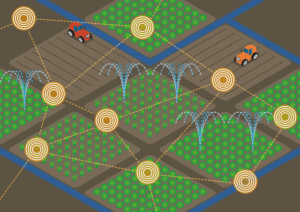AWS Solution Architect Certification Training
- 184k Enrolled Learners
- Weekend/Weekday
- Live Class
Internet of Things (IoT) is here to change the world we know. Smart cars, smart homes, smart cities, everything around us can be turned into a smart device with the help of Internet of Things. IoT sure does bring the coolness factor to technology. While IoT is poised to bring the next big boom in the job market, lack of skill is citing the biggest barrier for companies looking to implement this technology. To be considered in any of the roles mentioned earlier, you’ll need to be industry ready. Now, if you are starting to wonder what is IoT, you’ve stumbled onto the right page, this blog will get you going with the basics of Internet of Things.
Internet of Things (IoT) is a network of devices which can sense, accumulate and transfer data over the internet without any human intervention.
What makes living things alive? They can sense and communicate with each other, can’t they? Now imagine if inanimate objects could sense and interact with each other without any human intervention. Sounds amazing doesn’t it?
This is pretty much the underlying concept of Internet of Things.

Now that we have understood what exactly is IoT, it’ll be interesting to have a look at the evolution of internet.

Pre-Internet
In the pre-internet era, most of the human to human communication was through fixed and mobile telephony.

Dawn of Internet
With the origin of Internet the world changed at once. We could be continents apart and still share vital information at just the click of a button.

Internet of People
After the invention of blogging, social media began to explode in popularity. Sites like MySpace and LinkedIn gained prominence in the early 2000s. YouTube came out in 2005, creating an entirely new way for people to communicate and share with each other across great distances.

Internet of Things
Nearly all of the data available on the Internet today was first captured and created by human beings. The problem is, people have limited time, attention, and accuracy, which means they are not very good at capturing data about things in the real world,so, if we had computers that knew everything there was to know about things, using data they gathered without any help from us, we would be able to track and count everything and greatly reduce waste, loss and cost and this is what gave birth to “Internet of Things”.
By now you might have understood that IoT is not just Internet-connected consumer devices. In fact, IoT is the technology that builds systems capable of autonomously sensing and responding to stimuli from the real world without human intervention. We therefore need to develop a process flow for a definite framework over which an IoT solution is built. The IoT Architecture generally comprises of these 4 stages:

A thing in the context of “Internet of Things”, should be equipped with sensors and actuators thus giving the ability to emit, accept and process signals.

The data from the sensors starts in analogue form which needs to be aggregated and converted into digital streams for further processing. Data acquisition systems perform these data aggregation and conversion functions.

Once IoT data has been digitized and aggregated, it may require further processing before it enters the data center, this is where Edge Analytics comes in.

Data that needs more in-depth processing gets forwarded to physical data centers or cloud-based systems.

Natural Disaster Management with IoT

The Internet of Things platform can be used to accumulate data related to a specific geographic location using remote monitoring tools and perform analytics so that early warnings of a disaster can be found out.
Better Health-Care with IoT

IoT can have a major impact when it comes to remote health monitoring. Even though the patient is on the move, his vitals can be continuously sent to the doctors with the help of IoT platform.
Smart Farming with IoT

The task of irrigation can be automated with the help of IoT. A set of sensors such as light,humidity,temperature can be used to continuously monitor the field conditions.
Smart Energy Management with IoT

With smart grids energy distribution can be optimized. These grids also keep collecting real-time data which helps in distributing electricity efficiently and also to reduce the outages.
Pollution Control with IoT

The IoT platform helps us to continuously monitor the air quality and water quality. This data will be sent to the cloud, where further analytics can be performed so that a proper action can be taken to control pollution.
Hoping that this blog was helpful to you. If you want to learn more about IoT and how to work with Raspberry pi, you can check out our IoT tutorial blog.
Now that you have understood the basic concept of the Internet of Things,you can check out Edureka’s IoT Training Using Azure. Internet of Things is an ecosystem of connected physical objects that are accessible through the internet. According to the Gartner report, by 2020 connected devices across all technologies will reach 20.6 billion. As per the Cisco report, IoT will generate $14.4 trillion in value across all industries in the next decade. All of this will lead to better job opportunities. The Certification Training aims at covering all these new concepts around the Enterprise Application Development.
Got a question for us? Please mention it in the comments section and we will get back to you.
 Thank you for registering Join Edureka Meetup community for 100+ Free Webinars each month JOIN MEETUP GROUP
Thank you for registering Join Edureka Meetup community for 100+ Free Webinars each month JOIN MEETUP GROUPedureka.co